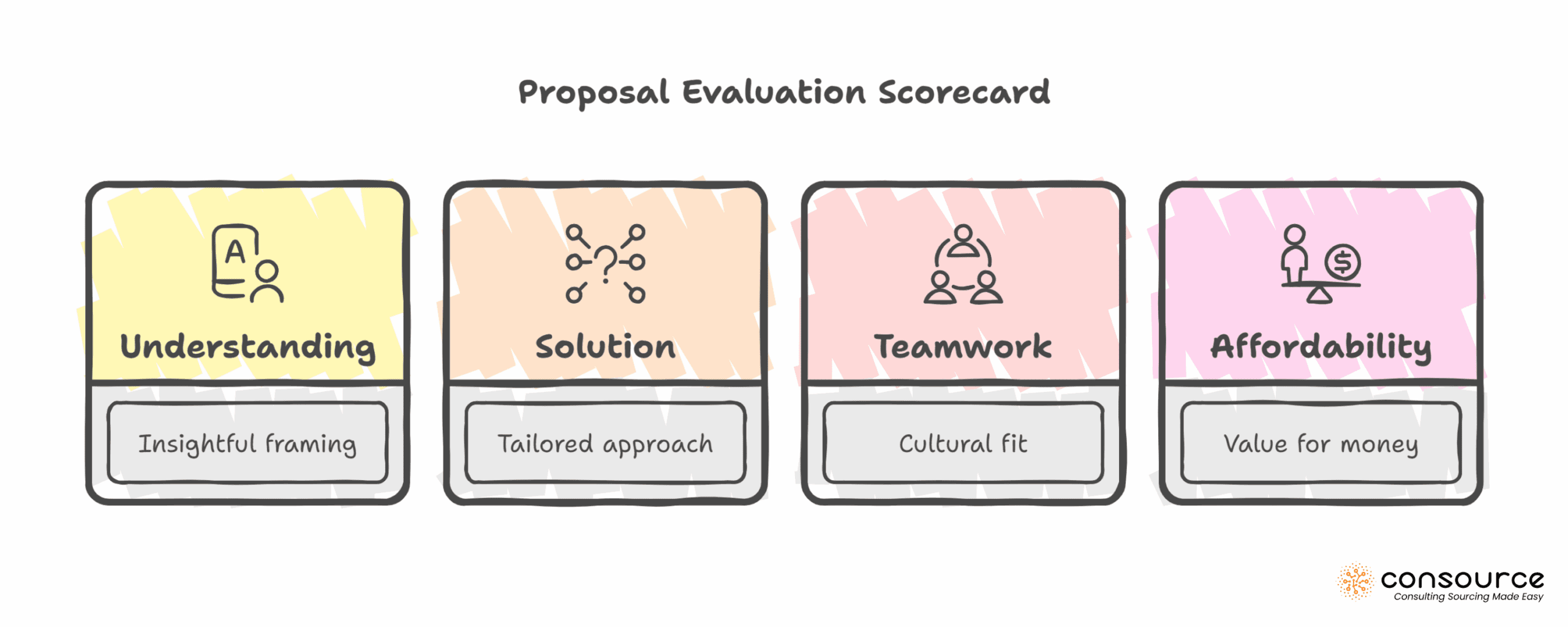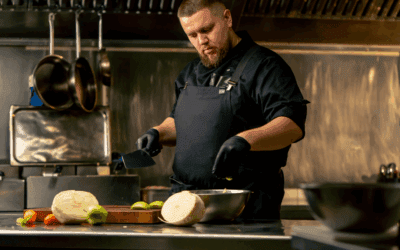Choosing a consulting firm isn’t just about credentials or price—it’s about making a strategic investment. The right partner can unlock new value, fast-track transformation, and bring clarity where it matters most. But too often, the selection process is rushed, fragmented, or driven by perception instead of performance.
That’s where leading organizations are flipping the script.
They’re treating consulting sourcing like a strategic category—using data, structured evaluations, and digital tools to make better decisions, faster. They’re not just asking “Who looks good on paper?” but “Who delivers the most value for this specific need?”
In this guide, we’ll show you how to:
- Define what “right” means for your context
- Evaluate proposals based on facts, not fluff
- Streamline decision-making across stakeholders
- Avoid common traps that derail consultant performance
And most importantly, we’ll show you how platforms like Consource.io are reshaping the way top-performing organizations approach consulting firm selection—from intake to evaluation to award.
Because selecting a consulting firm shouldn’t feel like a gamble. It should feel like a strategic win.
1. The Stakes of Consulting Firm Selection
Selecting the right consulting firm is not a mere administrative step—it’s a strategic decision that can significantly shape project outcomes, stakeholder engagement, and ultimately, business impact. Yet, it’s often rushed or guided by convenience, internal politics, or familiarity rather than a disciplined, needs-based evaluation.
The Hidden Costs of a Mismatched Partner
A poorly chosen consulting firm can lead to more than just unsatisfactory deliverables. Misalignment can cause delays, erode trust internally, inflate budgets through scope creep, and even damage the credibility of the sponsoring team. Projects that start with promise can end up shelved—not for lack of effort, but due to lack of fit.
The Consultant You Know Might Not Be the Consultant You Need
It’s common to gravitate toward familiar firms, especially those already embedded in your organization. However, this can be a trap. Just because a firm has performed well in one area doesn’t mean they’re equipped for a new challenge. For example, a firm renowned for strategy might falter on implementation-heavy work. Similarly, an expert in European market expansion may not be the right choice for an AI operating model overhaul.
Understanding the type of consulting you need—from advisory to implementation, niche expertise to broad transformation—is the first and most critical step in narrowing the field. Clarity here ensures you don’t fall back on habitual choices when a fresh approach is what’s truly required.
For practical guidance on how to evaluate firms beyond brand name and familiarity, review this guide to finding the right consulting firms.
Balancing Stakeholder Alignment and Procurement Discipline
For procurement teams, there’s often pressure to steer projects toward pre-vetted firms or those already under frame agreements. While this supports compliance and improves spend under management, it may not always serve the project’s best interest—especially if the existing panel lacks the required expertise or flexibility.
Well-built panels can help, but even they must be revisited through the lens of actual need. True strategic sourcing starts not with the supplier list, but with the problem to be solved. Building alignment across internal stakeholders—including business sponsors, finance, and legal—is essential to define that problem accurately and translate it into precise selection criteria.
2. Key Evaluation Criteria for Consulting Firms
Once you’ve clarified the type of consulting support you need, the next step is to identify which firms should be invited to the table. Whether you’re building a longlist or narrowing down candidates for a formal RFP process, evaluating potential partners against the right criteria is essential.
Here, we’re not just assessing firms—we’re assessing fit, trust, and executional confidence. And while firm credentials matter, never forget: in consulting, it’s the people who deliver the value.
Expertise and Industry Knowledge
First and foremost, assess whether the firm brings the right functional expertise and sector experience. A digital transformation for a healthcare provider is not the same as for a logistics company. Nuance matters.
But be wary of marketing language. Every firm claims to be “expert” in everything. Look for evidence: what types of projects have they completed? In which industries? Are they speaking from deep experience, or simply stretching past wins into unrelated domains?
This is where past performance and specialization should be scrutinized—not only at the firm level, but at the individual consultant level.
Track Record and Case Studies
Firms should be able to demonstrate relevant experience through detailed, anonymized case studies. These should describe the challenge, the approach taken, and the results achieved—not just vague testimonials.
Don’t settle for generic success stories. Ask:
- What was the client’s context?
- How similar is it to ours?
- What obstacles did they overcome?
- What were the measurable outcomes?
These case studies should reinforce the firm’s ability to adapt methodologies to your specific environment, not just deliver cookie-cutter frameworks.
Cultural Fit and Communication Style
Success in consulting is not just about the “what,” but also the “how.” Even the best advice falls flat if it’s delivered in a way that alienates stakeholders or clashes with internal culture.
Consider how the firm operates:
- Are they collaborative or top-down?
- Do they listen more than they speak?
- Will they flex their approach to align with your internal processes and tempo?
Cultural fit is often underrated but can be the difference between a smooth engagement and ongoing friction.
Resource Availability and Team Composition
This is where reality checks in. The proposal might be signed by a partner you know and trust, but who will actually be doing the work?
Ask for clarity on:
- The core team proposed, especially the project manager or lead.
- Their individual bios, experience, and past projects.
- Expected availability—especially during critical phases.
Consulting is a people business. Expertise resides in individuals, not logos. And with high industry turnover, firms often pitch with senior faces and deliver with junior ones. Probe the resumes. Challenge assumptions. Ask for assurances.
Ultimately, when selecting firms to invite into your RFP process, you’re not just inviting companies—you’re inviting specific people with specific skillsets into your most strategic initiatives. Evaluate them accordingly.
3. Structuring the Evaluation Process
Once you’ve shortlisted consulting firms to invite, the real work begins: organizing a fair, consistent, and insightful evaluation process. Too often, selection turns into a beauty contest—driven by slide polish or brand familiarity rather than substance. A structured approach ensures that decisions are based on what truly matters.
To do this well, procurement and business leaders need to co-create a framework that aligns selection with project goals and organizational realities.
Setting Clear Selection Objectives
Start with the end in mind. What outcome are you trying to achieve through this consulting engagement? Is the goal strategic transformation, compliance fulfillment, cost reduction, or capability building?
Your selection criteria should reflect the nature of the problem, the expected deliverables, and the impact timeline. For instance:
- A time-sensitive compliance project may prioritize speed and precision.
- A transformation initiative may emphasize strategic insight and cultural alignment.
- A capability-building engagement might focus more on knowledge transfer and team collaboration.
Deliverables: What Will Be Tangibly Produced
Consulting is an intangible service—but that doesn’t mean you can’t (or shouldn’t) be crystal-clear on the tangible outcomes.
Too often, deliverables are vaguely described—“recommendation report,” “transformation roadmap,” “capability uplift”—without enough detail. This ambiguity leaves too much room for interpretation, misaligned expectations, and post-signature frustration.
Instead, ask:
- What are the specific deliverables expected at each phase of the project?
- Are these outputs clearly linked to project goals?
- Are interim deliverables defined to allow progress tracking and iteration?
- Will the firm provide documentation, training materials, dashboards, or tools?
- How will success be measured, and by whom?
Ensure these deliverables are clearly outlined in the proposal—and that they are evaluated as part of your scoring framework, not negotiated as an afterthought.
Standardizing Your Evaluation Framework
Creating a common scorecard for evaluating proposals and presentations is essential. This prevents bias, enables clear comparisons, and ensures accountability.
The framework should address four critical questions:
- Did the consultants understand my business and the problem I’m trying to solve?
Look for evidence in how they frame your challenge. Are they repeating your brief, or showing signs of deeper analysis and insight? - Do I believe they can help me solve this problem?
Assess whether their proposed approach is tailored, feasible, and clearly linked to outcomes. Generic frameworks with little adaptation should raise flags. - Do I see myself—and my team—working well with them?
Chemistry matters. Will they adapt to your culture? Are they listening actively? Do they seem collaborative, or doctrinaire? - Can I afford their services?
Cost isn’t just about the number on the proposal. Consider the value delivered per euro spent. Can the project be phased or scoped to optimize ROI?
Deliverables should directly inform your judgment on points 2 and 4—they serve as a proxy for both quality and value.

To go deeper into how to implement one, consult this comprehensive guide to evaluating consulting proposals.
Involving the Right Internal Stakeholders
Avoid making the selection in a silo. Consulting projects often touch multiple departments or require strong executive sponsorship. Bring in stakeholders early—from the project sponsor to legal and finance—and ensure each has a voice in the evaluation.
At the same time, define roles clearly. Who owns the decision? Who advises? Who evaluates specific dimensions (technical vs. strategic vs. financial)?
A multidisciplinary evaluation team fosters both rigor and buy-in. It also ensures that firms aren’t chosen solely based on who sells the hardest, but on who truly fits the challenge at hand.
4. Comparing Proposals: Beyond Price
At first glance, consulting proposals can look similar: slides with methodologies, confident charts, a few case studies, and a fee structure. But under the surface, they can represent vastly different levels of involvement, risk, and expected impact.
A disciplined comparison process looks beyond appearance—and especially beyond price. Cheap doesn’t mean cost-effective. Expensive doesn’t always mean better. The real question is: which proposal delivers the highest return on investment for your specific situation?
Quality vs. Cost: The Consulting Paradox
Consulting is an investment. The paradox many organizations face is balancing high-quality execution with budget constraints. But focusing too narrowly on cost is one of the most common—and most costly—mistakes.
Take this example: you’re launching a new product, and accelerating time-to-market by even one month could generate significant revenue. A higher-priced consultant with the right experience and streamlined processes could save that month. In such a case, paying more for speed and precision makes financial sense.
By contrast, selecting the lowest bidder without assessing delivery risk or impact might save money upfront—but lead to project overruns, rework, or missed opportunities.
Instead of comparing raw pricing, ask:
- What value will this consultant unlock for us?
- Will their approach lead to sustainable outcomes or just deliverables?
- Is their pricing aligned with the depth and breadth of engagement required?
Assessing Methodology, Deliverables, and Risk Mitigation
When reviewing proposals, pay particular attention to how the work will be done—not just what will be done.
- Methodology: Is it cookie-cutter or tailored? Do they demonstrate an understanding of your context, or simply apply their standard playbook?
- Deliverables: Are they clearly defined, actionable, and aligned with your goals? Or are they vague and prone to interpretation?
- Risk Mitigation: What risks do they anticipate? How will they address resistance, misalignment, or changing business conditions?
You’re not just buying slides—you’re buying a journey. The right proposal should make you feel that your challenge has been truly understood, and that the path forward is both credible and flexible.
How to Interpret Resource Allocation and Timelines
Staffing plans tell you a lot—often more than the price tag. Who’s on the team, and how much time are they dedicating to your project?
A proposal with fewer consultant hours might be cheaper—but it might also mean less engagement, slower progress, or heavier workload on your internal team. Conversely, a more hands-on firm might seem expensive, but could reduce internal friction and accelerate delivery.
Ask yourself:
- Does the staffing match the complexity of the project?
- Are the senior profiles actually involved, or just selling?
- Will our internal teams have the bandwidth to carry their side of the project?
Timelines should also be evaluated strategically. If a project is time-sensitive—like regulatory compliance, crisis response, or first-mover advantage—delivery speed could be more valuable than any line-item savings.
Fit-to-Need: The Ultimate Filter
Finally, don’t let proposals dazzle you with flashy designs or discounted pricing models. The core question is: Does this proposal give us what we need to succeed?
- Does the approach solve our specific problem?
- Are the deliverables the ones we truly need—not just the ones that “look good”?
- Are we buying a solution—or a promise of one?
A well-structured comparison process makes this judgment possible. And when done right, it enables you to justify your choice with confidence—not just on cost grounds, but on the full spectrum of strategic, operational, and financial impact.
5. Leveraging Technology: Consource.io’s Role
Despite the strategic importance of consulting engagements, many organizations still rely on spreadsheets, scattered emails, and manual tracking to manage their selection process. This lack of structure makes it difficult to ensure consistency, transparency, and fairness—especially when multiple stakeholders and high-stakes decisions are involved.
Digital platforms like Consource.io change that.
Consource.io was built specifically for managing the complexity of consulting procurement, helping organizations turn a fragmented process into a structured, insight-driven workflow.
Standardizing the RFP and Evaluation Process
One of the key advantages of using Consource.io is the ability to standardize how RFPs are issued and evaluated. With built-in templates and customizable scorecards, procurement and project leaders can ensure that all invited firms receive the same brief, are evaluated on the same criteria, and that no proposal falls through the cracks.
This structure allows stakeholders to focus on what matters most:
- Is the proposal aligned with our needs?
- Are the deliverables well defined?
- How does the pricing compare, in terms of ROI?
Consistency also enables benchmarking—not just within a single project, but across categories, business units, and timeframes.
Centralizing Proposal Data and Team Feedback
Proposals, notes, and evaluations often sit in different inboxes or files. Consource.io centralizes this information, making it easy for evaluation teams to collaborate asynchronously, leave structured feedback, and track decision rationale.
This is particularly useful when:
- Multiple teams are involved in the evaluation process
- Several rounds of shortlisting are needed
- Documentation for governance and audit trails is required
Everything is kept in one place, with version control and clear attribution—helping teams stay aligned and agile.
Driving Consistency Without Sacrificing Flexibility
Every project is different. Consource.io provides the structure needed to avoid chaos, while allowing flexibility to tailor RFPs, weight criteria, or adjust evaluation steps based on project specifics.
Whether you’re sourcing a boutique for a niche market study or a global player for a transformation initiative, the platform supports fit-for-purpose workflows—without forcing you into rigid templates.
Turning Decision-Making Into a Repeatable Advantage
Perhaps most importantly, digital tools like Consource.io turn every selection into a learning opportunity. Over time, you build a repository of:
- Which firms were invited and why
- How they scored and performed
- What trade-offs were made
This institutional memory is invaluable. It transforms consulting sourcing from a reactive activity into a strategic capability—anchored in data, not anecdotes.
6. Real-World Best Practices and Common Pitfalls
Even with a well-structured evaluation process and the right digital tools in place, success is never guaranteed. The quality of consulting outcomes often hinges on how diligently the process is followed—and how carefully human factors are managed.
In this final section before we conclude, we explore proven best practices from leading procurement organizations, and the pitfalls that most often derail otherwise promising engagements.
Best Practices: What High-Performing Organizations Do Right
- Start with the Need, Not the Panel
While preferred supplier panels offer speed and compliance benefits, top-performing organizations treat them as starting points—not constraints. They revisit panel composition regularly and allow flexibility for specialized needs that fall outside existing relationships.
- Invest in the Briefing Process
Strong sourcing starts with a strong brief. Effective buyers spend time refining the scope, expected outcomes, and constraints. They engage stakeholders early and ensure that all invited firms receive the same briefing—eliminating ambiguity and reducing noise in the proposals.
- Evaluate Collaboratively, Not in Silos
The best evaluation processes are cross-functional and collaborative. Procurement, business sponsors, and technical experts bring different lenses. When these perspectives are integrated into a single scorecard, organizations make better decisions—and achieve stronger internal alignment post-selection.
- Document the Decision Trail
Organizations with mature sourcing practices document the reasoning behind each decision—not just for compliance, but for learning. Over time, this creates a feedback loop: which criteria correlated with project success? Which signals were misleading?
- Look Beyond the Pitch Team
Proposals often highlight senior profiles who may never touch the project. Sophisticated buyers dig deeper—verifying that the people who will actually do the work are visible, credible, and committed.
Common Pitfalls to Avoid
- Over-Reliance on Past Relationships
Just because a firm has worked with you before doesn’t mean they’re right for this challenge. Loyalty is important—but should never override fit.
- Letting Price Drive the Decision
As we’ve seen, choosing the lowest bidder often means sacrificing value, speed, or quality. True cost-effectiveness comes from alignment between project goals, consultant capabilities, and deliverables.
- Ignoring Internal Readiness
Even the best consultants can’t succeed if internal stakeholders aren’t aligned or available. Underestimating the internal workload, or failing to prepare teams, can stall even the most well-designed engagements.
- Skimming the Deliverables
A proposal full of big ideas but vague deliverables is a red flag. If you don’t know exactly what you’re buying, you’re setting the stage for disappointment.
- Confusing Brand with Capability
Global brand names carry weight, but consulting is a people business. The question isn’t “Do we know the firm?” but “Do we trust the team they’re putting in front of us?”
Conclusion: Make Every Consulting Selection a Strategic Win
Choosing the right consulting firm isn’t a matter of instinct, brand recognition, or price. It’s a strategic decision—one that can accelerate growth, unlock innovation, or, if mishandled, stall critical initiatives.
As we’ve explored throughout this guide, successful sourcing requires:
- Clarity on the problem you’re solving
- Rigorous evaluation of firm and individual fit
- A structured process that balances qualitative insight with quantitative comparison
- A focus on ROI—not just cost
- Tools and frameworks that promote consistency, collaboration, and learning
Above all, it requires the discipline to ask the right questions and the courage to prioritize value over comfort.
In a world where consulting spend is rising and expectations are higher than ever, organizations that master the selection process gain more than just better projects. They build a capability—one that compounds with every engagement, every learning, every decision made right.
Ready to elevate how your organization sources and selects consulting firms?
Book a free walkthrough of Consource.io and see how our platform transforms your evaluation process from fragmented to strategic—ensuring every consulting dollar is invested where it delivers the most value.









0 Comments